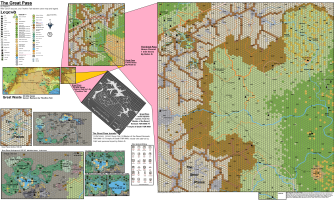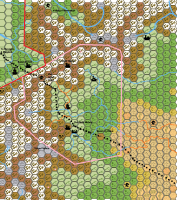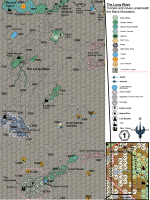
Map of The Great Pass
by Robin1 Mile Per Hex
This is the result from upgrading the existing 72 and 24 mile hex map to a 8 mile hex map and finally a 1 mile hex map.
All available data was used to create this.
Finally with the use of all gamers on The Piazza about this map Great Pass it even evolved into this.
The Gazetteer evolved from this work will become avaiolable soon.
The Giant Statues in the Snow Planes Caves actually are created to hold the upper caves up....as such they are created existing stone pillars, are cope these...the exterior however resembles oltec personalities.
29-04-2015 Updated; Added exit caves from the Catacombs.
the catacombs will be displayed in a smaller seperate map.
30-04-2015 updated; Added ice caves, named a glacier (Arkham Glacier), placed Frost Giants and Undead locations. added forgotten tunnels from Paradise Cave.
20-05-2015 Updated; Altered the Hex underneath Kapycöl Kane…Aka “The Master’s Fist” to Mountainous, as to fit descriptions of Julius Cleaver from The Piazza
21-05-2015 Updated; Added the ?eytan pençesi Location as by Julius Cleaver's information.
26-05-2015 Updated; Added Borders of Hule (red) and the Republic of Gnomes (pink). Also added area of effect borders of the Magical points (Pink circle)
8 Miles Per Hex
This is part of an ongoing process.
The mapping of the Great pass through the Black Mountains between Hule and the Sind Desert in 1 mile hexes.
I use Thorfinns map of the Sind Desert, The Official map of the Great desert m, and of the Great Pass itself.
I had to listen to not only the maps but also to the story line, and normal natural ecology.
The following is as copied from the adventures X4 and X5.
Everything in Red seemed important to me, and all of this thus changed the map of the sind Desert accordingly.
FOOTHILLS TO THE PASS:
The mountain foothills are different from the desert hills
bent and twisted pine grows on the land, and streams flow through the area, carrying water from the Black Mountains beyond.
The hills are very rugged, cut with ravines and bluffs. The ground, though covered with trees and grass, is dusty and rocky.
If players take time to hunt, they may find antelope and other small game. The air is somewhat cooler than the desert below, although the temperatures still average about 80 degrees during the daytime. To the west, the tops of the Black -Mountains rise above the horizon, their peaks often disappearing into banks of icy clouds. Even from this distance, the characters can tell the peaks are tall, jagged, and icy.
1st mark... (I call this area "The Bowl of 4 men")
Your party is travelling through a light stand of trees that grow near the base of a rocky bluff. Travel is difficult: the trees and loose shale force you to detour often. As you finally reach the top of a low ridge, you discover a large, bowl-shaped clearing on the other side. At the lower, far end are four giant-sized statues. Their features are nearly worn away, and it is difficult to tell that they are carved to represent old men. Each stands with his hands folded in front of him. Hidden behind the statues is a small cave.
2nd mark (The Evil Abbey)
Your party has been riding across the treeless plain for several days now. A light snow has fallen and the air is quite cold. Then one of your group points to something in the distance. There, outlined by the black mass of the mountains and the white snow, you see a small line of red. Another hour passes as you ride toward it, and now you can tell it is a line of roofs. Some time later, you see a group of buildings clustered on a craggy rock. Finally, close, you can see what must be the monastery. A broad staircase climbs the cliffs to a gate above.
The Evil Abbey is located very close to the shadow of the Black Mountains. By the time the characters reach the abbey, they will have passed the treeline and will be crossing alpine meadows. A large point of rock juts above the level of the surrounding area. The top of this rock has been cleared, and the abbey built upon it. It is surrounded on all sides by steep cliffs (the heights are marked on the map). A broad staircase climbs from the base of the rock to its entrance. This staircase of 999 steps is carved from the rock of the peak. Rising from the plain, it climbs to the main gate of the monastery.
The abbey was once the home of a number of Lawful monks, at the heart of a large village now long since destroyed. Long ago, the village was destroyed, burned and plundered by a band of evil raiders. Surrounded, the monks of the abbey were trapped. For nearly a year, they held out, carefully rationing their supplies, but finally, the inevitable came, and they were overrun and killed almost to a man. However, since the abbey is so far from civilization and deep in the heart of the enemy territory, no word has ever escaped concerning their fate.
THE BLACK MOUNTAINS:
This massive mountain range is among one of the highest and most dangerous mountain chains in the known lands of the campaign Its peaks are permanently ice covered, and large glaciers fill many of the high valleys. From a distance the mountains appear white and dull blue, but when viewed more closely, the blue becomes dull gray, barren rock.
Most of the mountain land is well above the treeline, even above the highest of the meadows that cover the lower slopes. Travel through the mountains is nearly impossible except at certain passes and trails: any traveller who tries to climb through the mountains will confront a lack of food, snow-covered crevasses, avalanches, cliffs, cunning monsters, freezing cold, and air so thin he cannot breathe. If the characters attempt to cross at some place other than a pass, they will die unless they turn back.
The Great Pass lies in the Black Mountains, one of the highest and most forbidding mountain chains in the known lands of the campaign. Here peaks are permanently ice-covered, and large glaciers fill many of the high valleys and saddles. From a distance the mountains appear white and dull blue, but when viewed closely, the blue becomes dull gray, barren rock. Most of the mountain land is well above the treeline, even above the highest of the alpine meadows that cover the lower slopes.
The entrance to the first tunnel of the Great Pass is in a narrow box canyon, half a mile long. The mouth of the canyon is 20 yards wide. Cliffs 300’ high rise up on either side. The canyon twists and turns at this same width for half a mile and ends in a large open area one mile across. At the far side of this bowl is a cave mouth 30 from the ground. A ramp of packed earth runs from the ground to the opening.
However, an hallucinatory terrain covers the mouth of the canyon. If the players have directions to the entrance of the Great Pass, they will reach the mouth of the canyon with no difficulty. A heavily trampled path leads up to the canyon mouth and appears to end in a blank cliff wall. If the players are searching without a map, they will eventually find this path. If the cliff wall where the trail ends is touched, it disappears, revealing the canyon mouth.
The tunnels through the Black Mountains are natural passages. The floors are irregular and cluttered with fallen stone and stalagmites. Water and ice film the walls. Puddles dot the floor. The walls and ceilings of the tunnels are also jagged and rough. The tunnels are 11 to 20 yards wide (1D10+10) and 11 to 30 yards high (1ld20+10). Players will not be able to keep an accurate track of time while in the tunnels. Fungus grows in patches throughout the tunnels, 70% of which is deadly poison. If a player eats any of the poisonous fungus, he must save vs. Poison or die.
The tunnels through the Black Mountains connect to three different valleys. These valleys are well above the treeline, but lush green carpets of alpine flowers, lichens, and mosses cling to the rugged rocks and boulders. The ground is moist with the runoff from the surrounding glaciers. The valleys are locked in by the mountain peaks. A few small creatures live in the valleys-small rodents that gather berries and plants, and falcons and hawks that prey on the rodents. Mountain goats dwell near the edges of the valleys. Any other creatures in these valleys are listed under the specific encounter for each valley
Basic ecological information;
Very High Mountains, well above Tree line, with glaciers next to a vast desert.
A lot of evaporation , if water would be available.
Heat will not be much available high in the mountains , but wind and weather will be locked almost right above the mountain chain, where most will fall down on the mountains themselves or in the west of Hule. Hence the eastern area becomes a vast desert.
Some runoff of the glaciers will create a small semi-fertile area clutched to the mountains.
Trees are there, but the wind, sand and drought has twisted them.
Alpine meadows are higher, against the rockwalls. (a new Icon I created for this...faded green with 2 minor hills)
There are 2 major structures, and a stone bowl like depression with a rock and 4 statues
Reason to go here in this area must be logical; since the village was large there must have been another boon than only a clergy and/or the tunnel.
There was spoken in some other canon source that the Blackmountains were once renowned for the find of the most beautiful diamonds.
So a diamond mine would seem logical....(abandoned however.)
The evil raiders spoken of could have had there origin in Hule or in the Great pass itself.
The tunnels are natural, thus could only have been created by a few causes. (erodation through water (former glaciers) in the three valleys, or by the mentioned availability of Purple worms. The problem lies here that even purple worms dig (eat) only through packed earth or weaker consistency and NOT through stone. Hence I see only water as the most logical cause,since the black map of X4 reveals puddles and ice within.
I will add an underground version to show this clearer.. The water could have went further down, or out of the mountain, and later evaporated in the area.
Underneath the Black Mountains 1 Mile Per Hex
These are the underground tunnels that were mentioned to exist underneath the Black Mountains.
I've laced them between the Great Pass (northern part of this map), underneath Arkham Glacier and towards the Southwest touching the top of the underground Realm of the Bel-Ek-Witznay (see also Great Pass map).


